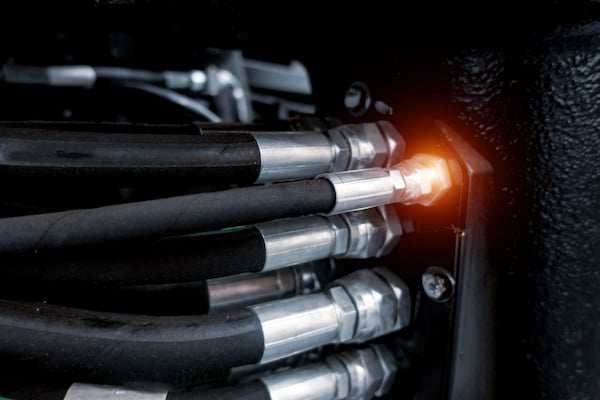
Do Not Ignore Hydraulic Leaks
Even small, seemingly insignificant leaks are warning signs of what could be a broader problem in the system, often causing failures and longer downtimes. Additionally, if fluid is leaking, it’s likely that contaminants can enter the system. Even the smallest dirt particle or air in the line can cause hydraulic system failure. Therefore, immediately repairing hydraulic fitting leaks or any leaks found in the system is critical to its service life. As remarkable as it may seem, preventable leaks are the cause of over 100 million gallons of hydraulic fluid seeping into the environment each year in the U.S. alone.First Confirm the Fitting is the
Source of the Leak
As with all leaks, drips will occur at the lowest point of gravity.When a leak starts at the ridge of your roof, it often ends up dripping from a valley down to the middle of your ceiling. Similarly, hydraulic fluid dripping from a fitting could be coming from higher up in the assembly. Before assuming it’s the fitting, check the assembly components and hose above the dripping fitting to identify the actual source of the leak. If you assume it’s the fitting and replace it without checking the rest of the system, it may continue to leak and you’ll end up with more extensive repairs and longer downtime.
Some Hydraulic Fitting Styles Leak More Than Others
Removing and reinstalling fittings can make them prone to leaks. Despite this, some hydraulic fitting styles O-ring Face Seal and O-ring Boss are okay to reinstall if the O-ring is still in good shape or is replaced, and the threads are in good condition. However, for other styles such as JIC or NPT, removing and retightening can strip the threads, causing a path for hydraulic fluid to leak. JIC and NPT are designed to be leak tight when first installed but are not intended to be removed and reinstalled. If these fittings need to be removed, they should be replaced.Depressurize the System Prior to Any Repair
Before repairing hydraulic leaks, be sure to depressurize the system. Otherwise, it can lead to a dangerous and explosive discharge of hot hydraulic fluid causing damage to the system-- and worse, to human life (see “Proper Safety Precautions” below.) Just turning off the machine will rarely eliminate trapped back pressure.Be Sure to Take Proper Safety Precautions When working with Hydraulics
Beyond what’s stated above, there are other safety guidelines for dealing with leaking fittings. One very important precaution is to NOT use your bare (or even gloved) hands when checking for a leak. A hydraulic hose assembly is usually under very high pressure and the fluid is exceptionally caustic and can be extremely hot. One pinhole leak can send fluid under high pressure, causing hydraulic injection to the skin where the outer layer of skin is broken by a jet of fluid under pressure. Hydraulic fluid entering the bloodstream can quickly result in amputation of a limb or even death. At the very least, bacteria can be driven into the wound, causing dangerous infections.Final Reminders
Other practical (and somewhat obvious) steps to take when fixing hydraulic fittings are:
- Do not over-tighten the fitting
- Replace O-rings on hydraulic fittings
- Use a torque wrench whenever possible. The proper torque value is very important because it represents how tight the fitting connection should be for a system running at high pressure.
- Use the Correct hydraulic fitting
In addition, make sure to use hose clamps to hold the assembly in place where necessary and be sure the hose is long enough to properly route through the assembly. Otherwise, the hose can crimp, causing it to leak or pull fittings out of place.
Learn more about hydraulic maintenance here:

